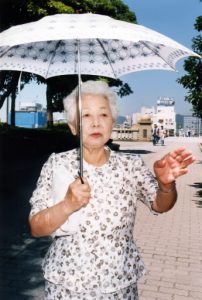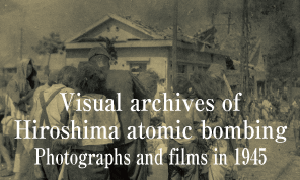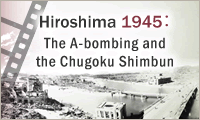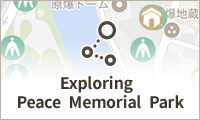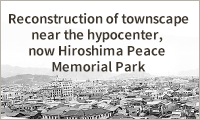Sarugaku-cho, neighborhood around A-bomb Dome, Part 4: “Secret story” of Aioi Bridge
Jul. 28, 1997
Young woman witnesses American POW killed in A-bombing
One of the so-called “secret stories of the A-bombing” describes how, on the day after the atomic bombing, an American Prisoner of War (POW) was hung from an electric pole on Aioi Bridge near the A-bomb Dome. The soldier, trying to escape, is said to have been captured by angry citizens and tortured to death. The story became embellished as it was being handed down orally from person to person, with some spreading the exaggerations as if they were fact.
For a long time, the U.S. military had denied its soldiers were in Hiroshima beneath the A-bomb’s mushroom cloud. In 1983, however, it officially acknowledged that American POWs — eight from the U.S. Army and two from the Navy — had died in the atomic bombing. However, some questions remain, including the actual death toll. The Record of the Hiroshima A-bomb War Disaster, edited by the Hiroshima City government in 1971, only contains a brief description of that situation. “Soon after the atomic bombing, before disposal of the dead bodies began, an American military POW died at the base of an electric pole on the north side of the east end of Aioi Bridge…,” reads the account.
Body wrapped to electric pole with metal wire
“Yes, I clearly remember a young American soldier being tied to the foot of an electric pole with metal wire.”
Toshiko Kurata, 71, a resident of Hiroshima City’s Higashi Ward, made that statement about how she had seen the dead American soldier on the south side of the streetcar tracks, around 50 or 60 meters east of Aioi Bridge, not on the day after the bombing as it has been often told until this point in time, but on the day of the atomic bombing itself, August 6, 1945. Her home was just a stone’s throw away from the site. Her maiden name was Kasai. Her family was managing an umbrella manufacturing and wholesale business at the address “49-1 Sarugaku-cho.” She had graduated from Hiroshima First Municipal Girls’ School (present-day Funairi High School) and was working at the Mitsubishi Heavy Industries’ Hiroshima Shipyard, located around 4.3 kilometers from the hypocenter.
Ms. Kurata added, “I was told to stay at the work site, but I got a piece of hardtack and left.” Avoiding the fires that had arisen after the bombing, she traveled north along the riverbank of the Tenma River, walked down the streetcar tracks from Funairi to Dobashi, and headed to the hypocenter. She reached Aioi Bridge around 7 p.m.
On the west side of the bridge, she saw the scene of a fallen horse and six soldiers lying face down both in front of and behind the animal. When she crossed the bridge, which was bereft of all signs of life, she found the American soldier with his feet thrust forward and his head bowed, wearing canvas shoes on his bare feet. Wire was wrapped around his upper body, clothed in a khaki uniform, and was connected to the base of the still-standing electric pole.
She was unable to enter the ruins of her home, as fires continued to smolder there. The next day, she met up with her two younger brothers and younger sister in Hiroshima’s present-day Saeki Ward, where her mother’s younger sister and her husband were living. One of her younger brothers, six years younger than she, returned home with severe burns after experiencing the atomic bombing near Tsurumi Bridge, in Hiroshima’s present-day Naka Ward, where he had been mobilized for work as a student.
Ms. Kurata said, “I was 19 years old and the oldest daughter. Only the children in the family survived the bombing…” Her father, Ihei Kurata, 49, went missing after leaving home to participate in building-demolition work. Her mother, Kimiko, 43, had returned from where she had evacuated one day before the atomic bombing and died at home. The post-war ordeal for the four children began at that time.
She would occasionally talk about what she witnessed at Aioi Bridge on the day of the bombing in private settings, but at some point she gradually stopped sharing the story. She had become too busy with the production of ice cream, the family business she engaged in with her husband, who died three years ago, to have any awareness of the fact that the scene had become a “secret story.”
Junior high-school students at the time remember the soldier
When these reporters were visiting people with connections to the area of Sarugaku-cho, two men, junior high-school students at the time, were found to have also witnessed the dead young American soldier on the east side of Aioi Bridge, but on the day after the bombing. The location they described slightly differed, but both told the same story of rubble strewn around the soldier’s feet. The two men also declared that they had thrown things lying around the area at the body in anger, just as other passersby did.
Was he the same American POW Ms. Kurata had seen? There is no way to verify that information now. But she recounted her experience that day once again as she stood at the actual site.
“When I saw his body, there was nothing like stones around him, and it appeared as if he might just stand up and walk away. My only thought was that an American soldier had died with others at such a spot, and I felt sorry for him. I felt like I was having a dream or seeing an illusion.”
That “secret story” of Aioi Bridge was also a “heartbreaking story” that conveys the insanity of war.
(Originally published on July 28, 1997)

